The Dragon Demands (talk | contribs) Tag: Source edit |
The Dragon Demands (talk | contribs) Tag: Source edit |
||
| (One intermediate revision by the same user not shown) | |||
| Line 121: | Line 121: | ||
President Dugan and the Pentagon's military command staff were briefly mind-controlled, before being rescued and evacuated from Washington DC. Before the city totally fell to the Soviets, the American government and military Commanders reallocated its HQ to [[Canada]] and struggled in a rapidly losing fight. |
President Dugan and the Pentagon's military command staff were briefly mind-controlled, before being rescued and evacuated from Washington DC. Before the city totally fell to the Soviets, the American government and military Commanders reallocated its HQ to [[Canada]] and struggled in a rapidly losing fight. |
||
| − | While Russian army groups entered Texas, [[Cuba]] launched an amphibious invasion of Florida to the east. Both groups advanced, linking up in Alabama by the second week of the war. Four weeks into the war, Russian and Cuban armies massed in Georgia for a push against the major city of Atlanta.<ref>[[Texas DMZ |
+ | While Russian army groups entered Texas, [[Cuba]] launched an amphibious invasion of Florida to the east. Both groups advanced, linking up in Alabama by the second week of the war. Four weeks into the war, Russian and Cuban armies massed in Georgia for a push against the major city of Atlanta.<ref>[[Texas DMZ campaign]]</ref> |
[[File:Ls800a04.png|thumb|Soviet forces advance from the southwestern states to Chicago, splitting the USA in half, along with amphibious landings taking cities on the east coast.]] |
[[File:Ls800a04.png|thumb|Soviet forces advance from the southwestern states to Chicago, splitting the USA in half, along with amphibious landings taking cities on the east coast.]] |
||
The main thrust of the Soviet invasion spread from the southwest across the Great Plains to the Mississippi, covering over a quarter of the country, while the amphibious Soviet saliants in the northeast had spread in all directions. From Illinois, the Soviets mounted a drive on [[Chicago]], an offensive which would cut the remaining free parts of the USA (in the northwest and eastern seaboard) in two. |
The main thrust of the Soviet invasion spread from the southwest across the Great Plains to the Mississippi, covering over a quarter of the country, while the amphibious Soviet saliants in the northeast had spread in all directions. From Illinois, the Soviets mounted a drive on [[Chicago]], an offensive which would cut the remaining free parts of the USA (in the northwest and eastern seaboard) in two. |
||
| Line 152: | Line 152: | ||
===European front=== |
===European front=== |
||
| − | [[File:Ls800a10.png|thumb|The Soviets launch a massive |
+ | [[File:Ls800a10.png|thumb|The Soviets launch a massive offensive campaign crossing through southern Germany.]] |
After the initial drive by French and German forces into Eastern Europe was repulsed in the opening months of the war, the Soviets counter-attacked by advancing into neutral Sweden and Norway, to lay claim to the warm water ports that would allow them to build large fleets and strike anywhere along the northern coast of Europe. As the war entered its fourth month the Allies grew bold and began new major attacks into Poland from Austria, striking against Soviet bases and liberating thousands of Polish civilians. The Soviets responded quickly with three armored divisions that swept into eastern Germany, cutting off the Allied attackers.<ref>[[Red Storm campaign]]</ref> |
After the initial drive by French and German forces into Eastern Europe was repulsed in the opening months of the war, the Soviets counter-attacked by advancing into neutral Sweden and Norway, to lay claim to the warm water ports that would allow them to build large fleets and strike anywhere along the northern coast of Europe. As the war entered its fourth month the Allies grew bold and began new major attacks into Poland from Austria, striking against Soviet bases and liberating thousands of Polish civilians. The Soviets responded quickly with three armored divisions that swept into eastern Germany, cutting off the Allied attackers.<ref>[[Red Storm campaign]]</ref> |
||
Revision as of 18:21, 13 March 2022
The Third World War, also known as World War III, was a global conflict, triggered by an invasion of the United States by forces from the Union of Soviet Socialist Republics two decades after the end of the previous war.[1] The Allies had won the war, but the rise of Yuri forced them to use the time machine to repeat the war and stop the psychic from taking over the world.
Origins
The Allies had won the Second World War and suitably, they set about "declawing" the Russian bear. They forced it to disarm, removing its MiGs and missile submarines, and installed a puppet dictator, Alexander Romanov. Although an aristocrat and a member of the Communist Party, Romanov was an outward advocate of peace.[2]
He did what the Allies wanted him to do: turn the Soviet Union into a benevolent force. It was benevolent, for a time, establishing relationships with other socialist countries and giving humanitarian aid. But despite this seemingly benign foreign policies as secretly, Romanov seethed with anger and bitterness. He thought of his predecessor, Stalin and how the Allies destroyed his beloved motherland.[3]
As such, Romanov made the decision to rebuild the Soviet Union as a military power. Unable to build MiGs, he researched Kirov airships and developed the technological marvel of tanks, being the most mighty and advanced tank of all: the Apocalypse tank. He also found other "resources", such as Yuri, a powerful psychic.
He also found General Vladimir, an excellent tactician. But best of all he formed, a very formidable navy ranging from Typhoon Subs to Dreadnoughts, the world would finally see the Soviets rival the Allies in terms of naval powers. Then, he made his move. Premier Romanov built up the World Socialist Alliance, outwardly a loose alliance meant to distribute peaceful economic aid to other socialist nations. Iraq, Libya and Cuba joined with the Soviet Union in the new alliance.[3]
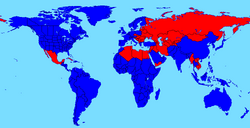
World Socialist Alliance members, including Russia (in red) on the eve of Red Dawn and Lone Guardian. Blue is all of the Allies on the map.
Ultimately, socialist Mexico joined the WSA; the Soviet Union would then used a local revolution in Mexico as an excuse to move Soviet military forces from Mexico without arising any suspicions. In reality, the Soviets had moved a massive portion of their land army to Mexico, and was amassing amphibious assault fleets from Soviet fleets in both the Pacific and Atlantic Oceans.[3][2]
The Invasion Begins
| “ | Soviet invasion confirmed! - Ben Carville, confirming the President of the United States' worst fears(src) |
” |
One day, President Michael Dugan gets a phone call from General Carville. Dugan received the news of a full Soviet invasion. Both coasts were under threat from Soviet Kirov airships and Soviet naval forces were staging amphibious landings, along the northeastern coast. In a masterfully coordinated attack, Soviet troops that had been deployed in Mexico were racing across the Texas border as well. Along at least the eastern and western fronts, Soviet planes deployed huge numbers of paratroopers to sow confusion and weaken American pockets of resistance.
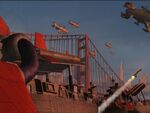
The Soviet ships and their destructive weapons.
In the face of such massive Soviet power and realizing that a swift victory was the only way to prevent a massive war on American soil, President Dugan ordered an American nuclear response. However, he did not realise that the US military nuclear command channels had been compromised, allowing Yuri to transmit a signal that mind-controlled its listeners.
The mind-controlled nuclear silo crews launched their nuclear missiles, while the silo doors were still closed, making them harmless for the Soviets at least: exploding underground. With its nuclear arsenal disabled, the US had to bear the full weight of the invasion. During the early phases, Soviet forces benefited from both superior forces and the element of surprises.
Meanwhile, Soviet naval and aerial forces overran San Francisco and soon after that, the whole of the west coast fell with it. The Soviets then tried to capture New York City, but although they were successful in destroying the Statue of Liberty, they were unsuccessful in capturing the city itself. Agent Tanya was present in New York and destroyed the poorly defended Soviet supply base which had been hastily assembled. The recapture of New York would have to wait until later.
America Stands Alone
| “ | Romanov's sending his bulldog, General Vladimir, for our air bases. His forces are romping through the country like an angry bull in a Texas rodeo. - Ben Carville(src) |
” |
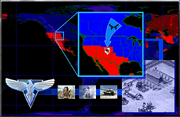
Soviet forces invade from Mexico, capturing the southwestern USA
The Soviet army's ground forces poured into the United States from Mexico, while naval and air forces attacked from the west and east, conducting a major amphibious landing in the northeast which quickly overran the region.
The scheme of Mutually Assured Destruction had broken down: the United States' nuclear arsenal had been destroyed harmlessly in their silos, but the Soviets were unwilling to use full-scale strategic nuclear weapons against American forces, as they wanted to conquer the mainland USA, not destroy it outright. Tactical nukes were used only sparingly by the Soviets during the war.
However, to "conquer" the stubborn American people, Soviet forces also began deploying "Psychic Beacons", developed by Yuri. Using the mind control powers of Yuri's Psychic Corps, the Soviets converted American civilians in conquered territory to be totally loyal slaves to the Soviet regime, thus stamping out most resistance before it started. Psychic Beacons were also used to enable the rapid fall of Washington, D.C..
President Dugan and the Pentagon's military command staff were briefly mind-controlled, before being rescued and evacuated from Washington DC. Before the city totally fell to the Soviets, the American government and military Commanders reallocated its HQ to Canada and struggled in a rapidly losing fight.
While Russian army groups entered Texas, Cuba launched an amphibious invasion of Florida to the east. Both groups advanced, linking up in Alabama by the second week of the war. Four weeks into the war, Russian and Cuban armies massed in Georgia for a push against the major city of Atlanta.[4]

Soviet forces advance from the southwestern states to Chicago, splitting the USA in half, along with amphibious landings taking cities on the east coast.
The main thrust of the Soviet invasion spread from the southwest across the Great Plains to the Mississippi, covering over a quarter of the country, while the amphibious Soviet saliants in the northeast had spread in all directions. From Illinois, the Soviets mounted a drive on Chicago, an offensive which would cut the remaining free parts of the USA (in the northwest and eastern seaboard) in two.
The American military staged an amphibious attack from across the Great Lakes to retake Chicago soon after the Soviets advanced into the city, where they discovered that the Soviets had installed a "Psychic Amplifier". If activated, it would mind-control the whole of North America. Fortunately, the Americans were successful in destroying the Amplifier and repulsed the Soviet advance into the city.
However, the enraged General Vladimir ordered a nuclear bomb dropped on Chicago, destroying the entire American relief army as well as a large portion of the remaining Soviet troops in the city. This was the only time in the war that a full-scale nuclear weapon was used, in order to destroy a major US city. With Chicago in nuclear ruins, a major remaining American army destroyed, and the nation cut in two, the United States' situation was dire.
European Involvement
| “ | Our men will go nowhere until this threat is eliminated! - German Chancellor(src) |
” |
However, the Soviets seemed to have bitten off more than they could chew. European countries, such as the United Kingdom, France, and Germany had up until this point been unwilling to enter the war, because they were afraid that, in response, the Soviet Union would attack them with nuclear ICBMs. The nuclear bombing of Chicago frightened the European leaders, and they later became receptive to American requests for aid. The European nations would join the war, contributing troops and funds, if a US commando mission led by Tanya had succeeded to destroy two ICBM silos, located along the Polish border.
In one of the most important missions of the war, Tanya was successful in slipping her team past the border and destroying the missiles. The Soviets hid their remaining missiles deep inside Russia for safety. Even though, this meant that they were out of range of any European targets and strategically worthless after this point.
French and German armies then pushed into Eastern Europe. Despite initial success, they soon found themselves surrounded on all sides by entrenched Soviet forces and were nearly surrounded in Romania, but made a fighting retreat back to friendly battle lines in the west.[5] Nonetheless, European entry into the war divided the Red Army between the North American and European fronts, taking pressure off of the USA. Perhaps more importantly, Professor Albert Einstein who was working out of his lab in the Black Forest of Germany was able to develop new technologies to share with the Americans. Perhaps the most notable of these was the Prism tower, designed to counter the threat of Soviet Tesla coils.
Using these new assets, American forces staged a large attack on Washington DC and in the ensuing battle, the capital city was liberated. Much of the city had been left in ruins and several landmarks vandalized, but the city was now free of any Soviet presence and the Pentagon also remained intact. The tide slowly started turning against the Soviets and American officials returned home afterwards.
The Soviet fleet then attacked Oahu, hoping to annihilate the US Navy at Pearl Harbor and capture the Hawaiian Islands in order to stage further attacks on the American west coast. While the Soviets were able to capture Kauai and Niihau, wiping out the American presence on both islands, they failed to capture Oahu and were eventually repulsed. The success of the American defense blunted the Soviet advance throughout the Pacific theater, taking more pressure off of the contested American mainland.
With battle lines fluctuating, the Soviets mounted a counterattack against St. Louis in the state of Missouri, using another Psychic Beacon to take control of the city. However, Tanya's commando team infiltrated the city and destroyed the Psychic Beacon located in the bombed- out Busch Memorial Stadium. Conventional forces were then freed to enter the city without fear of mind-control. By this point, the Allied army had adapted Einstein's Prism Tower technology into mobile Prism tanks. They served as a highly effective artillery unit, whose long range and heavy firepower proved devastating against enemy base defenses. St. Louis was liberated and the Soviets were again forced into retreat.
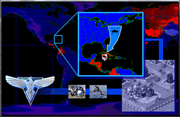
After expelling the Soviets from its territory, the USA launched counter-offensives deep into Mexico, and amphibious raids against Cuba.
With the capture of a West Coast Allied base, the Soviets also captured a Prism Tower. Subsequently, they tried to reverse-engineering the technology at a laboratory in Mexico's Yucatán Peninsula, hidden in the ancient Mayan ruins of Tulum. However, an assault by a crack team of American Navy SEALs was able to wipe out the lab. The Soviets had been completely removed from the northeast, and were rapidly being pushed out of the few areas of California, they still controlled.
Being pushed back on the battlefield, the Soviets started using some suicide bombers in a series of targeted assassinations, attempting to take out top Allied Generals and leaders. One of these attacks claimed the life of General Carville, the Supreme Allied Commander.
World-wide conflict
By this point in the war, the continental United States had been liberated and US forces were pushing into Soviet-occupied Mexico, but internationally the World Socialist Alliance still held a strong hand. The global conflict spread to almost every nation on Earth. Satellite countries in South America, Africa and Asia switched between Allied and Soviet control repeatedly.
European front

The Soviets launch a massive offensive campaign crossing through southern Germany.
After the initial drive by French and German forces into Eastern Europe was repulsed in the opening months of the war, the Soviets counter-attacked by advancing into neutral Sweden and Norway, to lay claim to the warm water ports that would allow them to build large fleets and strike anywhere along the northern coast of Europe. As the war entered its fourth month the Allies grew bold and began new major attacks into Poland from Austria, striking against Soviet bases and liberating thousands of Polish civilians. The Soviets responded quickly with three armored divisions that swept into eastern Germany, cutting off the Allied attackers.[6]
The Soviets realized that Einstein was responsible for many new technologies, the Allies were using to counter the advanced technology, the Soviets had been ready at the beginning of the war. Furthermore, they also learned that he was working on a new Chronosphere that would most certainly prove a great and posing threat to them. As a result, the Soviets mounted a massive drive from the Polish border westwards, capturing much of southern Germany, as they moved onto the Black Forest in the southwest corner of the country (however, Berlin remained under Allied control). In a massive battle, the Soviets attacked Einstein's residence in a three-pronged attack using their new technologically superior Apocalypse tanks, the ultimate land weapons. However, the Allies were able to stem the tide of the Soviet advance, thanks in no small part to Einstein's new Mirage tanks, which were capable of disguising themselves as trees for surprise attacks. After a grueling battle that claimed the lives of many German soldiers, the Soviets were repulsed and Einstein's lab was secured.
Meanwhile in the south, Soviet ally states attacked in the Mediterranean. While the Russians managed to persuade a few pariah warlord states to join their cause, most were only in the war for their own gain. It was a chance for many warlord nations to prey upon their neighbors, to expand their borders and to seize the resources they needed to maintain their failing economies. While Soviet forces fought around the globe, Iraq and Libya seized the opportunity for a joint invasion of southern Italy. With most Allied forces concentrated in the north and east against Russia itself, only a handful of French and English divisions were left in Italy to oppose them. The Soviet forces captured southern Italy, but the Anglo-French forces rallied at the Alps, holding the difficult mountain terrain of northern Italy.[7]
The Iraqi-Libyan forces them began a new offensive into Greece. Allied forces were stretched so thin in central Europe that the British and French could only bring a small force by boat from "India and French Malaysia" to offer token resistance. With their forces already divided in Italy, however, the Iraqi-Libyan offensive in the east did not advance beyond Greece itself as their supply lines stretched thin.[8]

Late in the war, Allied forces retook Scandinavia and captured Poland and Romania - then began pushing into Ukraine and the Baltics
Eventually the Allies made a renewed push in the southeast Mediterranean to gain naval access to the Black Sea. In the middle of winter, the Allies crossed the Black Sea to make a surprise amphibious landing in Ukraine. This was only a feint, however, meant to distract Soviet forces from a massive armored offensive back into Poland. This attack succeeded, and then from Poland the overland forces began to advance on the major Soviet bases in Ukraine itself. In the north, Scandinavia and the Baltic Sea regions remained heavily contested between Allied and Soviet naval forces. The Soviets made several small-scale raids around Britain meant to disrupt trans-Atlantic supply lines but they were repulsed.[9]
Asian front
The Republic of Korea joined the Allies in fighting the Soviets. The Korean government remained neutral during the first few months of the war until a Korean reporter learned that the Soviets had used Psychic Technology to mind control key members of the Korean leadership. When the story broke Korea went to war, and her commanders were to fight in almost every country in the Far East. The first attack took the Soviets almost completely by surprise as the Koreans fought along the coast of Japan for naval supremacy of the Pacific. This further divided and thinned out Soviet forces across the globe.[10]
As the Soviets continued to spread across South East Asia, consuming the small countries that stood in their way, the Korean Army dispatched two divisions to Vietnam to defend it against a major Soviet strike force, despite being outnumbered two to one. Three weeks after declaring war on the Soviet Union, however, Korean commanders faced an invasion of their own country by a secret Soviet division hidden from their intelligence network by powerful psychic technology. A skeleton defense force managed to hold back the Soviet invasion long enough for the Koreans to yank back all of their forces deployed overseas to push them out. They succeeded in driving back the Russians from South Korea itself, but at the cost of abandoning Southeast Asia.[11]
As Soviet forces began to be stretched thin in America and Europe, months later Korean High Command ordered a new offensive into Russia itself, targeting Vladivostok - the main Pacific port for the Russian Far East territories. Despite massive losses on the battlefield and from severe cold, as the war dragged on the Korean forces gradually advanced into the vital oil fields of Eastern Siberia, delivering a crippling blow to the Soviets' global war machine.[12]
Chrono-Invasion and Victory
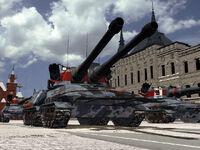
Black Guard Apocalypse tanks, moments before being obliterated by a Harrier airstrike.
Realizing that it would take many years and cost many lives to defeat the Soviets using conventional weapons, the Allies developed the plan to use Einstein's new Chronosphere to teleport an invasion force into Moscow, the capital of the Soviet Union.
Unfortunately, Einstein determined that in order to do this, the Chronosphere would have to be constructed at the perfect place within Earth's magnetosphere and this site turned out to be on an island in the Florida Keys, "only a few short kilometers from Soviet Cuba". However, Cuba was the home of several Nuclear Silos and Terrorists in forming a great and major threat to the Chronosphere's deployment.
The Allies starved off wave after wave of Soviet attacks and mounted multiple air and amphibious assaults on Cuba in order to destroy three Nuclear Missiles which were about to be fired against the Chronosphere. The Allied attack on Cuba succeeded and the Soviets watched helplessly as the Allies activated the Chronosphere.
With the Chronosphere completed, every able bodied unit was rushed through the Chronosphere for a full-scale chrono invasion of Moscow. With the element of surprise and most of the Soviet army out in the field, the Allies were able to push through the city in a fierce urban-to urban combat battlefield.
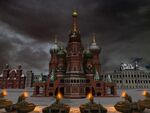
Prism tanks prepare to vaporize St. Basil's Cathedral.
Teams of Allied vehicles, an MCV, as well as other forces were teleported in. Suddenly, Soviet forces found themselves fighting a battle within Moscow itself. Although surprised, they still had an operational nuclear missile silo as well as the secretly rebuilt the Iron Curtain device, both of which would prove extremely useful.
However, the Allies encountered these threats with a Weather Control Device and the Chronosphere. The Allies, eventually overran the entire city defenses and eradicated the Soviet superweapons. After eliminating Romanov's Black Guard, which included some of the finest, most elite and advanced Apocalypse tanks in the Soviet Union, Romanov refuses to surrender and swore Allied death in a shout from the Kremlin. Agent Tanya was brought in and her team stormed the Kremlin. She eliminated Romanov's guards inside and eventually found the great man himself - down to his boxers and underwear. This moment of utter humiliation was made public in the newspapers around the world for the Allied Forces.
Romanov was brought to the Parliament Building in Great Britain and forced himself to sign a treaty, proclaiming that the Allies were victorious and that the Soviet Union would stand down. After the treaty was signed, he was locked away in the Tower of London. However, in the chaos of the bloody Battle in Moscow, the Allies overlooked one critical detail: Yuri was nowhere to be found. This would prove to be a critical mistake on the Allied part, as now the whole world was in greater danger than the conflict had already began...
Aftermath
The Third World War saw an Allied victory, one again and however, they did not escape completely unharmed. The United States infrastructure and military forces were utterly devastated by the attack of the Soviets. Countless civilians and cities were lost from both the armies clashing and the area of Chicago was left highly irradiated after the Nuclear attack.
Europe sustained slightly less damage, but was still hit and the city of Moscow was devastated by the Allied attack, again and Russia was broken down to keep it from making any further military action. After the ending and some time later, there's trouble for Michael Dugan at a White House meeting with Yuri.
Major events
Allied missions
- Operation: Lone Guardian - Agent Tanya was sent in to liberate Fort Bradley in New York from Soviet assault.
- Operation: Eagle Dawn - Tanya liberates the Colorado Airforce Academy from Soviet control in the Colorado Springs.
- Operation: Hail to the Chief - The Soviets infiltrated Washington and built a Psychic Beacon device, forcing Lt. Eva to bail out the brainwashed President Dugan from the White House.
- Operation: Last Chance - Allied forces destroyed a device that can Mind control the entire continent, if activated.
- Operation: Dark Night - Tanya and Allied Spies infiltrated Soviet-occupied Poland and destroyed the Soviet Nuclear Silos located there.
- Operation: Liberty - General Carville, fed up with being stuck in Canada, demands the liberation of the Pentagon.
- Operation: Deep Sea - The Soviets tried to avenge their defeat in Washington DC by attacking the US naval base at Pearl Harbor. General Carville says, "As if they can mount a successful attack against us."
- Operation: Free Gateway - St. Louis fell under Soviet Mind control. A task force led by Tanya is sent into the city in taking them out.
- Operation: Sun Temple - A Navy SEAL team is sent in to foil Soviet attempts to reverse-engineering Einstein's Prism technology.
- Operation: Mirage - The Allied Commander is hastily sent to Germany to defend Einstein's lab against the Soviets. Mirage Tanks were introduced here to ambush Soviet troops, hence the mission's name.
- Operation: Fallout - Soviet nuclear missiles on Cuba eliminated.
- Operation: Chrono Storm - The final battle of the Third World War. The Allies used the Chronosphere to invade and destroy the Black Guard in Moscow, capturing Premier Romanov.
Soviet missions
| The following is based on the Soviet campaign of Red Alert 2 and might contradict canon. |
- Operation: Red Dawn - Lt. Zofia says, "This is the first step in our glorious conquest." The Soviets attack and destroy the Pentagon.
- Operation: Hostile Shore - The American naval fleet was eliminated.
- Operation: Big Apple - A Psychic Beacon was deployed in New York.
- Operation: Home Front - The Republic of Korea attempts to take Vladivostok, while the Soviets were busy in the USA, but failed.
- Operation: City of Lights - The Soviets responded to the French who were joining the war by turning the Eiffel Tower into a giant Tesla Coil.
- Operation: Sub-Divide - The Soviets eliminated the combined fleets of Korea and the USA at Pearl Harbor.
- Operation: Chrono Defense - The Soviet Commander had to use the newly built, but technologically advanced and extremely powerful Apocalypse Tanks to defend the Battle Lab (which was researching the Tanks, as they were underdeveloped and lacked true potential) against the strongest anti-structure unit, the Prism tank.
- Operation: Desecration - The White House, "Home of the Corrupt", had to be captured to arrest General Vladimir.
- Operation: The Fox and the Hound - President Michael Dugan was captured via mind control.
- Operation: Weathered Alliance - The Soviets destroyed the Allied prototype, Weather Control Device.
- Operation: Red Revolution - Yuri was found to be a traitor and must be brought to justice.
- Operation: Polar Storm - The Chronosphere had to be destroyed before the Allies overwhelm Moscow.
References
- ↑ "Red Alert 2 picks up approximately 20 years after these events." Westwood Studios, Command & Conquer: Red Alert 2. Collector's Edition DVD - Propaganda - 01. Video Demo.
- ↑ 2.0 2.1 Westwood Pacific, Command & Conquer: Red Alert 2. Installation.
- ↑ 3.0 3.1 3.2 Red Alert 2 official site: Soviet History (archived). Westwood Pacific, 2000.
- ↑ Texas DMZ campaign
- ↑ European Theater campaign
- ↑ Red Storm campaign
- ↑ African Warlords campaign
- ↑ African Warlords campaign
- ↑ European Theater campaign
- ↑ Guardians of the East campaign.
- ↑ Guardians of the East campaign.
- ↑ Guardians of the East campaign.
| ||||||||||||
